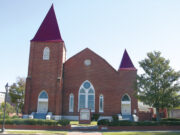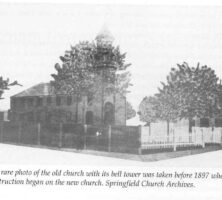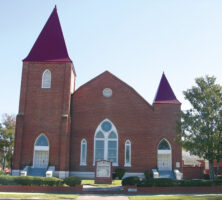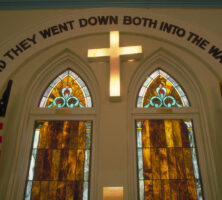Springfield Baptist Church in Augusta traces its roots to the year 1773, bolstering its claim to be the oldest African American congregation in the United States. Served by African American pastors during the antebellum years, Springfield had the largest membership of any church in the Georgia Baptist Association. Some of its members emigrated to Liberia, and the church maintained a missionary connection with that country.
Springfield offered Sunday school instruction in 1859, even though such classes were banned by the prevailing slave codes. In 1866 the church hosted the first meeting of the postwar Georgia Equal Rights Association, which became the Georgia Republican Party a year later. The Augusta Baptist Institute was founded at the church; twelve years later it moved to Atlanta and grew into Morehouse College.
Origins
Savannah’s First African and First Bryan Baptist churches have long contested with each other for the title of “oldest” church. The origins of the Augusta and Savannah churches are intertwined. Around 1773 a roving evangelist named Wait Palmer organized a church among George Galphin’s slaves at his Silver Bluff, South Carolina, plantation, located twelve miles below Augusta on the Savannah River. Among the original members were two who played major roles in black Baptist history, David George and Jesse Peters. George later left an account of his life, including his escape from slavery in Virginia, his flight into the Indian country, and his association with the traders employed by George Galphin. George recounted how “Brother Palmer formed us into a church and gave us the Lord’s Supper at Silver Bluff.” Galphin’s children taught George to read, and he began preaching to the little congregation on the plantation. George Liele, a slave of Henry Sharp and a member of the mostly white Buckhead Baptist Church, also preached at Silver Bluff.
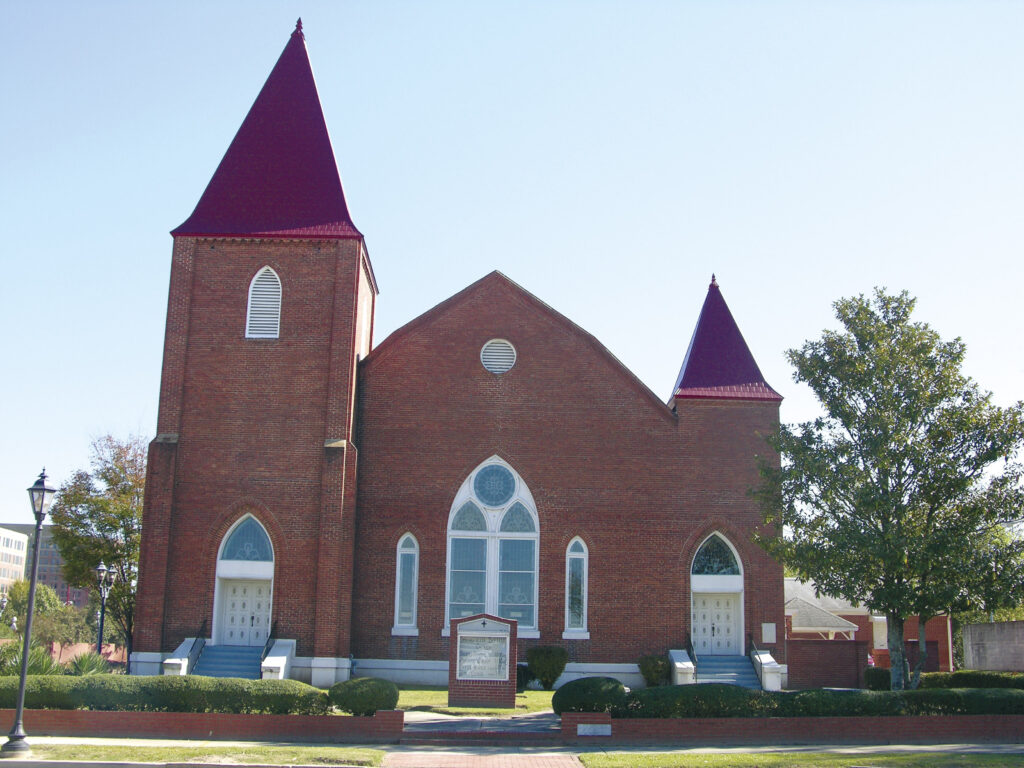
Courtesy of Augusta Convention and Visitors Bureau
George Galphin took the patriot side in the American Revolution (1775-83). In 1779, during the British occupation of Georgia, about ninety of Galphin’s slaves, among them George and Peters, sought refuge with British commander Archibald Campbell. They were later joined in Savannah by Liele, whose master was killed in a skirmish with patriot forces. The refugees formed a church in Savannah. When the British evacuated Savannah in 1782, George and many members of the church went to Nova Scotia and founded one of the first, if not the first, African American church there. The inhospitable climate, and an unfriendly reception by some of the inhabitants, caused George and his followers to migrate to Sierra Leone, where they established a church and a community. Meanwhile Liele and others of the Savannah church left Georgia for Jamaica.
Peters returned to Silver Bluff with members who chose to live in Georgia. According to an account given by Liele in Jamaica, Peters “preaches near Augusta, in South Carolina, where I used to preach.” Peters, who took the name Galphin, was likely a free black in 1788 when he joined white Abraham Marshall in ordaining Andrew Bryan in Savannah. Partly on the basis of that event, today’s Springfield Church uses the year 1787 as the date of its location in the village of Springfield, which was annexed by the city of Augusta in 1798. After studying the origins of the various churches, historian Walter Brooks concludes, “the oldest Negro Baptist church in this country today is that at Augusta, Georgia, having existed at Silver Bluff, South Carolina, from the period 1774-1775 to the year 1793, before becoming a Georgia institution.” The country’s first non-Baptist African American church was Richard Allen’s African Methodist Episcopal Church, established in Philadelphia in 1787.
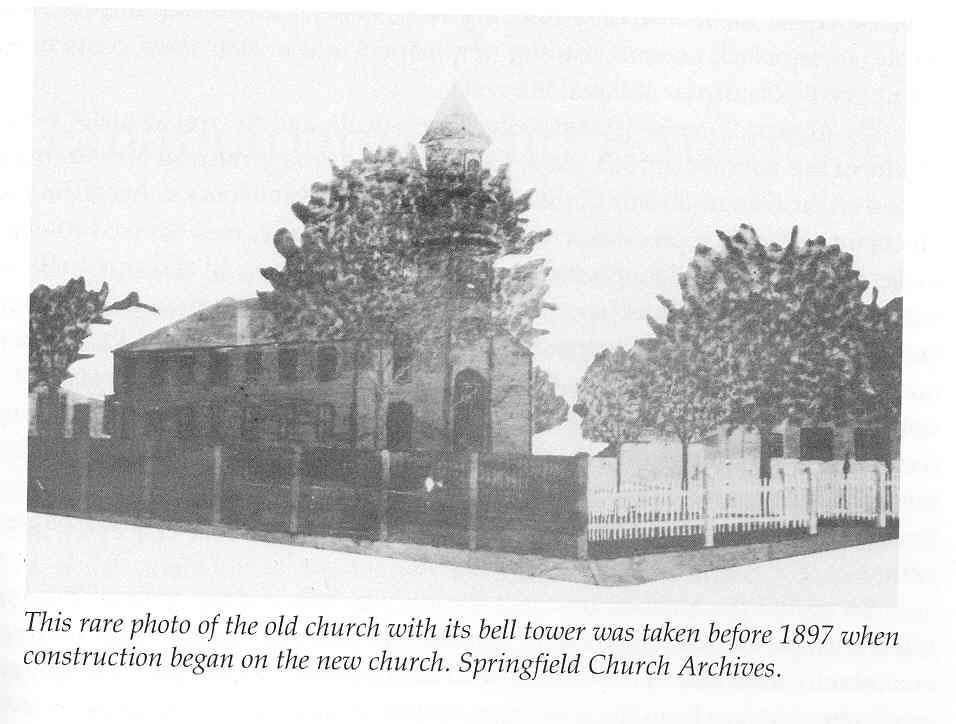
From Old Springfield: Race and Religion in Augusta, Georgia, by E. Cashin
Historian Mechal Sobel credits Springfield Baptist with 497 members in 1803. Following Jesse Peters Galphin’s death in 1806, Caesar McCredy and Robert McGee served as pastors. In 1824 Jacob Walker succeeded to the pastorate, and Springfield enjoyed its greatest period of growth, claiming 1,000 members to make it the largest congregation in the Georgia Baptist Association.
In 1840 Springfield established the first of several daughter churches. In 1844 the church purchased the building known as Asbury Chapel from Augusta’s St. John Methodist Church. The building, constructed in 1801, was moved several city blocks to the Springfield Church property on Twelfth and Reynolds streets and replaced the older church on that location. The building survives today as one of Georgia’s oldest church structures.
Reconstruction
Henry Watts presided over the church during the Civil War (1861-65) and Reconstruction (1867-76). On January 10, 1866, Springfield hosted a historic event as thirty-eight delegates from eleven Georgia counties met to form the Georgia Equal Rights Association. The members petitioned the Georgia legislature for the inclusion of blacks on juries, for civil treatment on railroads, and for the right to vote. On February 14, 1867, William J. White established the Augusta Baptist Institute at Springfield Church. Twelve years later the school moved to Atlanta and in 1913 became Morehouse College.
Thanks to the prodding of black leaders, Ware High School was founded in 1880 near Springfield Church by the Richmond County Board of Education. It had the distinction of being among the few high schools for black youth in the country. When the board decided to close the school in 1897, black plaintiffs appealed the decision to the U.S. Supreme Court. In a historic ruling delivered in 1899 in the case of Cumming et al. v. School Board of Richmond County, Georgia, the court allowed local boards of education to deal differently with the races in matters of education.
Under pastor George Dwelle, the congregation laid the cornerstone of a new brick church building in 1897 and used the older Asbury Chapel as its parish hall. The Reverend James Nabrit served as pastor from 1912 to 1921. His son, James Nabrit Jr., graduated from Morehouse College and from Northwestern University Law School in Chicago, Illinois; joined the faculty of Howard University Law School in Washington, D.C.; and rose to the presidency of that institution. He also served as deputy for U.S. supreme court justice Thurgood Marshall in the Brown v. Board of Education of Topeka case (1954) that reversed the policy set earlier in the Ware High School decision. Another son, Samuel Nabrit, also a Morehouse graduate, became president of Texas Southern University.
Recognition
Springfield Church received recognition from the city of Augusta in 1935, when the city celebrated its bicentennial. Various organizations marched in procession in order of their dates of origin. Kiokee Baptist Church came first, having been founded by Daniel Marshall in 1772. The Freemasons were allowed second place. The city accorded the Springfield delegation the honor of marching third. Sixteen white organizations followed. In 1976 Springfield pastor Emmett T. Martin took the lead in observing the nation’s bicentennial, the first in Augusta to do so. Official recognition of the church’s historic status came in 1982 with its listing on the National Register of Historic Places.
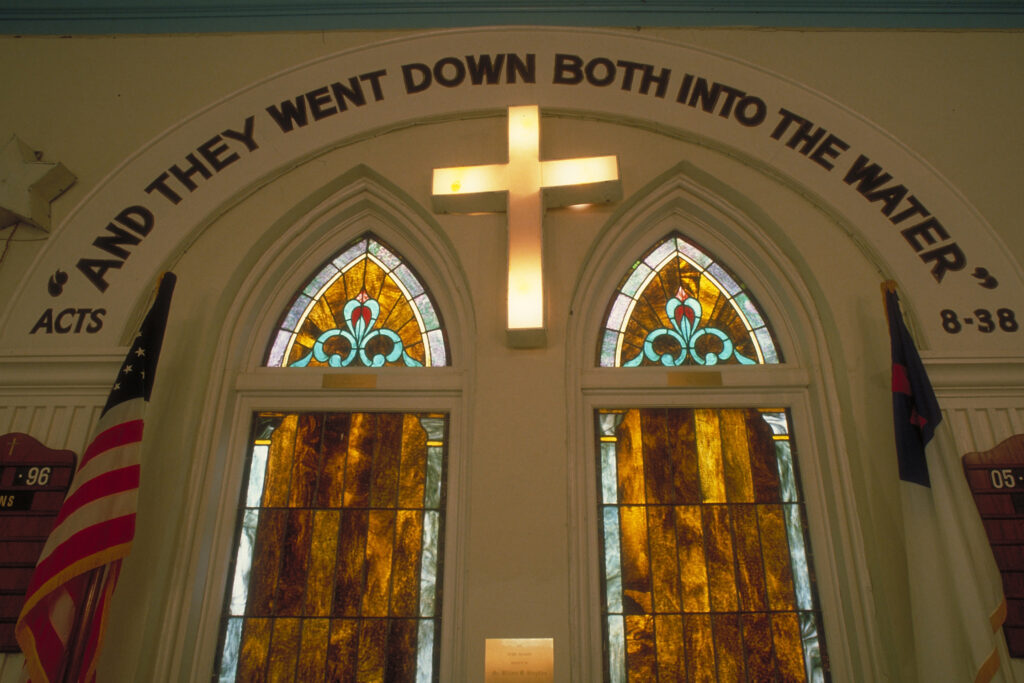
Courtesy of Augusta Convention and Visitors Bureau
In 1995 a coalition of city and community leaders began construction of Springfield Village Park adjacent to the church. The park features abstract metal sculptures by nationally known African American artist Richard Hunt of Chicago. Plaques along an ascending ramp tell the history of American blacks as well as the history of Springfield Church.


